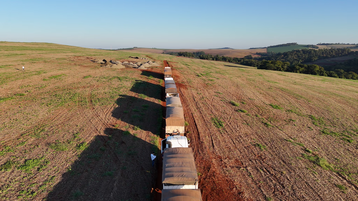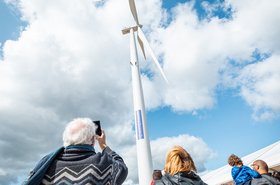As humanity continues the arduous task of weaning itself off fossil fuels, there has been an increased onus on the development of carbon removal technologies. Unlike capture and storage, these aim to remove CO2 permanently and durably from the atmosphere.
The data center sector has emerged as the biggest customer for carbon removal-related credits over recent years. Leading the pack is Microsoft, which in 2024 alone purchased eight million tons of durable removals. As part of its effort to become carbon negative, the cloud company has taken a scattergun approach to purchases, backing options from the technologically advanced, such as Direct Air Capture (DAC), to the holistic, such as reforestation programs.
One technology that has received strong backing from Microsoft is enhanced rock weathering (ERW). Earlier this year, the company signed a deal with Terradot, a firm born out of Stanford University’s Soil and Environmental Biogeochemistry Lab.
Terradot officially launched operations in December 2024, following the close of a $58 million Series A fund raise, and has also secured long-term backing from Google and Frontier – a carbon buying consortium including Meta and Google’s parent company, Alphabet.
Microsoft’s backing of Terradot was driven by its commitment to best-in-practice science, according to Brian Marrs, senior director of Energy & Carbon Removal at Microsoft. “This deal emphasizes science and highlights our thesis that carbon removal must continue to translate best-in-class science into action,” he said when reflecting on the agreement.
Terradots CEO and co-founder, James Kanoff, sat down with DCD to discuss the agreement, the intricacies of ERW, and the role the data center sector can play in turning the technology into an effective and verifiable source of durable carbon removal.
What on earth is ERW?
ERW is a fairly simple concept that is “just speeding up Earth’s natural carbon removal process, which has been regulating the climate for over a billion years,” Kanoff says.
It removes CO2 through a chemical reaction, called carbonation, where CO2 trapped in rainwater reacts with carbonic acid in rocks containing silicate minerals, such as Basalt. When rainwater interacts with the rocks, the CO2 it carries mineralizes and is stored in a solid carbonate form. The natural process currently accounts for the removal of one billion tons of CO2 every year, but, according to Kanoff, with some help, it could be accelerated significantly.
To speed up the process, ERW firms like Terradot mine silicate rock from quarries, which are then crushed to a powdery consistency (Kanoff likens it to “baby powder”) and spread over wide-ranging cropland. By expanding the surface area available, ERW firms claim that the potential for carbon-binding reactions increases dramatically, transforming a process that could take millennia into one that works at scale within a matter of years.
Unlike technologies such as DAC, which require massive new facilities, or reforestation programs, which can take decades to implement, ERW can leverage existing agricultural and mining infrastructure for near-term deployments. As Kanoff explains, “There are already thousands of quarries around the world – surrounded by farmland – that have all the crushers, spreaders, haulers, and loaders we need.”
As a result, proponents of ERW claim that compared to alternatives, the technology has the potential to offer a low-cost, simple, and fast scaling option for durable carbon removal. However, like many other carbon removal techniques, the sector remains very much in its infancy, with concerns persisting over the efficacy of its verification procedures and ultimately how much carbon it can effectively remove. Subsequently, at present, carbon-related ERW credits remain quite pricey, ranging from $300 to $400 a ton, according to carbon credit marketplace SuperCritical.
Despite this, ERW firms remain bullish that if scaled, the price per credit has the potential to drop significantly, with some projections as low as $25 per ton. Therefore, the major challenge facing the sector today is accelerating the learning curve of the ERW process, to determine what the best methods are to achieve maximal carbon removal, and in turn what regions are most amenable to its widespread roll out. It is here that offtakers like Microsoft play a significant role, not only in committing to large-scale removal purchases but also backing the projects themselves.
The perfect climate
While ERW works across the world, its overall efficacy is highly dependent on the climate conditions of the region. This factor played a huge role in Terradot’s decision to site its operations in Brazil. According to Kanoff, Brazil offered several key advantages that would allow for the successful scale-up of an ERW operation.
The biggest factor was the country’s tropical climate, which has been found, due to its high temperatures and rain, to lead to a faster rate of silicate dissolution, a crucial step in the rock weathering process. The speed of dissolution is not only crucial in the removal process but also in the generation of data, which allows the company to develop best practices at a much faster pace.
“Tropical environments weather rock faster – so our learning process is three times as fast, [which] on a tight climate timeline is huge,” said Kanoff. “The faster the weathering means not only higher levels of carbon removals, also more data, quicker validation, and a faster learning curve.”
Another major factor was Brazil’s sizable agricultural sector, with ERW highly dependent on extensive farmland for maximum productivity. The country has one of the largest agricultural sectors in the world, with more than 8.51 million km2 of agricultural land. Therefore, the country’s “vast farmland and hundreds of ideal rock quarries near farms” made Brazil stand out as the obvious option, Kanoff says.
With size comes experience. The Brazilian agricultural sector has extensive involvement with “rock-based fertilizers,” where rock dust is used to remineralize soil to improve crop yields.
Subsequently, Terradot has leveraged a ready-made agricultural partner network with experience and a vested interest in greater deployment of rock-based fertilizers, taking a locally minded approach as all the rock used is mined at quarries within 50km of where they are spread.
So far, the company has spread nearly 50,000 tonnes of rock across 2,000 hectares of land and expects to generate the first carbon credits tied to the project at the end of the year.
The attraction to Brazil was not solely technical, Kanoff contends, but also societal. In Brazil, soil acidification is a huge issue, with low pH levels leading to low nutrient availability for crops, adversely affecting yields. ERW helps remedy this as it provides “micronutrients that are beneficial to crops and help manage soil pH, so it ends up being a win-win.”
As a result, ERW can have a dual benefit in these communities, says Kanoff. “The idea that we can remove carbon and regenerate soils at the same time? That’s incredibly powerful.”
Microsoft’s backing
Microsoft is not new to the game when it comes to ERW, having previously signed agreements to purchase removal credits from Undo to remove 15,000 tons in Canada and the UK, Eion to remove 8,000 tons in the US, and Lithos Carbon to remove 11,400 tons.
However, the deal with Terradot differs from a traditional removal purchase.“They’re not just buying credits – they’re helping build the science,” Kanoff says. Therefore, instead of merely purchasing carbon credits, Microsoft has pledged direct support for Terradot’s field trials, lab work, and the data infrastructure that underpins the company’s ERW platform.
Kanoff argues that this makes the partnership particularly powerful because Microsoft is bringing not just capital, but systems thinking and technical expertise. “Tech companies are used to thinking in terms of scale, reliability, and latency, [which are] things that really matter when you’re dealing with a global carbon removal solution,” he says.
Terradot sees backing from the data center market as a means to supercharge the process of carbon removal towards being a cost-effective and scalable solution. Much of this is down to the willingness of data center firms to commit their capital and expertise to support the growth of these projects.
“Their demand helps scale up solutions like ERW while ensuring it’s done with scientific integrity. It’s not just about making their own footprint cleaner—it’s about catalyzing a whole new ecosystem of climate solutions,” Kanoff says.
A crucial space where Microsoft and other data center operators can support carbon removal technologies is through the validation of carbon credits. This ensures the credits purchased are of high quality and drives improvements in the overall verification process, which could have a positive impact on the verification of other projects.
Verification verification verification
One major concern that permeates the carbon removal sector at large is the accurate measurement and verification of how much CO2 a technology removes.
This is especially true of ERW. Due to the lack of long-term field trials, it is still not certain how much CO2 ERW captures on a large scale. In addition, there is a lack of data on how different rocks, soil, and climate have on the efficiency of the removal. Different companies are experimenting with various silicate rocks, including basalt, wollastonite, olivine, and crushed concrete, which differ in terms of weathering rates.
As a result, verification is a central priority for Terradot, with the Microsoft deal seen as a means to accelerate both validation and deployment: “[We are] measuring everything from the topsoil down to groundwater… examining both near-field and far-field zones and trying to really understand the system,” says Kanoff. “The whole idea is to demonstrate true, durable carbon removal in a way that can stand up to scientific scrutiny.”
In doing so, Terradot aims to generate as much data as possible, which it can use to inform the validation process of its carbon removal credits, with the ultimate goal of creating a standard for true, durable carbon removal. Partnering with a cloud provider like Microsoft supercharges this effort, as they “can help us model, analyze, and improve in near real-time. That’s how this becomes scalable, repeatable, and trustworthy,” Kanoff stated.
As a result, Terradot firmly sees itself as part of a new wave of carbon removal, which focuses on permanent carbon removal, rather than sequestration and storage. In ERW, where carbon capture occurs in complex, dynamic systems, “verifying removal is the entire challenge.”
For this reason, Terradot is investing heavily in AI, synthetic data, and process-based models to build a foundation of scientific integrity. The company has also partnered with carbon registries like Puro and Isometric and has made a concerted effort to exceed standard protocols associated with carbon credit verification. In 2022, Puro became the first company to launch a carbon crediting methodology for ERW, which provides verification through the form of CO2 removal certificates.
While ERW remains early in its development cycle, several players have already begun to emerge across a range of climates and geographies. These include InPlanet, Undo, Vesta, and Eion, who are piloting ERW from Canada to Kenya, among many others.
The show of confidence from large-scale data center firms, such as Microsoft and Google, is proving crucial in supporting the growth of these companies. While most are merely focusing on the purchasing of credits, some, like Microsoft, are “investing in actual, durable carbon removal,” says Kanoff.
Doing so, they are supporting companies like Terradot in scaling quickly without fear of financial collapse, which permits a natural learning curve where companies can scale gradually. While there may be bumps in the road going forward, in determining whether ERW can be deployed at scale and verified effectively, the technology is very much here to stay as a crucial part of hyperscalers’ push to decarbonize their value chain through carbon offsets.
Read the orginal article: https://www.datacenterdynamics.com/en/analysis/enhanced-rock-weathering-geochemistry-at-hyperscale/








